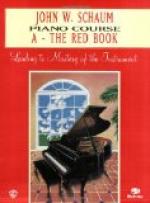“I am very susceptible to color, anywhere, in anything—especially in pictures. Music should express color. Certain compositions seem to embody certain colors. As you suggest, red is certainly the motif of Chopin’s great Polonaise, Op. 53.”
* * * * *
Mr. Burnham should certainly look forward to success in his visit to his native land. His fine touch and tone, sincere and musicianly style, and buoyant, genial personality will make friends for his art and himself everywhere.
XVI
EDWIN HUGHES
SOME ESSENTIALS OF PIANO PLAYING
When one has read with pleasure and profit the published ideas of a musical worker and thinker, it is always an interesting experience to meet such an one personally, and have the opportunity to discuss points of special import, particularly when the meeting can take place in some ideal spot in the old world. Such was my thought in visiting Mr. Edwin Hughes, an American who has made a name and place for himself among the pianists and teachers of Europe. After years of study in Vienna with Leschetizky, where he also acted as one of the Vorbereiters, he has established himself in Munich, where he feels he has found a true home of music and art. Here, amid beautiful and artistic surroundings, he lives and works, dividing his time between teaching and concert playing. As a pianist Mr. Hughes has met with gratifying success in the most important cities of Germany, while as a teacher he has been sought by students from almost every State in America, from Maine to Texas, and also from Canada. What has given him special satisfaction is that during the past year a number of pupils have come to him from the Conservatory here in Munich. They have been greatly pleased with their progress, only regretting they had not come to him before.
As to whether he uses the Leschetizky method in its entirety, Mr. Hughes testified in the affirmative.
“If you were to ask Leschetizky about the ‘Leschetizky Method,’ he would probably laugh and tell you he has no method, or he would tell you his ‘method’ consists of only two things—firm fingers and pliable wrist.
“These are the principles upon which I base the technical training of my pupils. I first establish an arched hand position, and then test the firmness of the fingers and knuckle joints by tapping them. At first the joints, particularly the nail joints, are very apt to sink in when tapped by a lead pencil; but by having the pupil continue the tapping process at home, it is not long before he acquires the feeling of conscious firmness in his fingers.
“Along with this exercise it is most important to begin at once with wrist exercises, as otherwise, from the effort to acquire firmness of finger, the wrist may become stiff and unwieldy. The wrist exercises consist in raising and lowering this joint, with the hand and arm supported first on each finger separately, then on two, three, four and five fingers. The wrist should not be so limp as to be incapable of resistance; but rather it should be like a fine steel spring—a ‘spring-wrist,’ I call it—capable of every degree of resistance or non-resistance the quality of tone demands.




